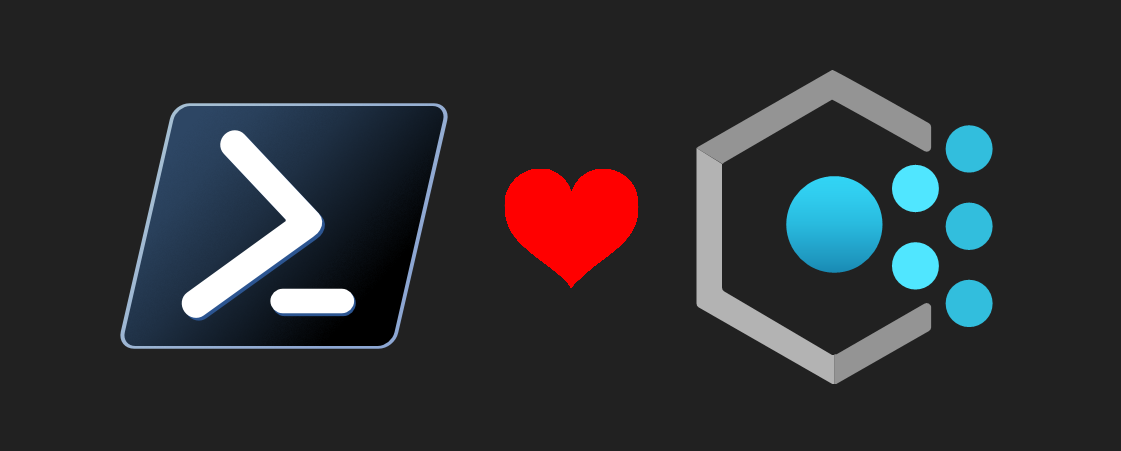
As the number of policy resources grows, EPAC is designed to be an toolkit to handle policy resources at scale, with Infrastructure as Code (IaC) in mind.
What is EPAC
Enterprise Azure Policy as Code (EPAC) is a declarative and idempotent desired state deployment technology for Azure Policy. It handles the creation, updating and deletion of policy resources.
EPAC comes as a collection of PowerShell scripts to manage Policies, PolicySets, Policy Assignments, Policy Exemptions and Role Assignments. There are also scripts for operational purposes such as remediation tasks and documentation of policy resources.
To fully automate the management of policy resources with EPAC, it is recommended to implementing EPAC in a CI/CD system such as GitHub Actions or Azure Pipelines.
EPAC has three major steps in the deployment process, each has it’s own cmdlet in the module.
- Build-DeploymentPlans - Analyze policy resource files and calculate desired state delta
- Deploy-PolicyPlan - Deploy policy resources at their desired scope based on the plan
- Deploy-RolesPlan - Deploy role assignments for Managed Identities, required for
DeployIfNotExistsandModifyPolicies
Install EPAC
EPAC comes as a powershell module published on the PsGallery, you can see the full project on their github repository.
Find-PSResource -Name EnterprisePolicyAsCode
Name Version Repository Description
---- ------ ---------- ----------
EnterprisePolicyAsCode 10.10.0 PSGallery Enterprise Policy as Code PowerShell Module
Install-PSResource -Name EnterprisePolicyAsCode -Repository PSGallery -TrustRepository
Import-Module EnterprisePolicyAsCode
Prepare ALZ hierarchy
EPAC supports using a canary environment for testing purposes. This environment will just be a duplication of the prod ALZ management group hierarchy. In this section I will create both environments with bicep and powershell. Continuing I will only work in the prod environment, the canary environment will be left available for future use.

New-Item -Path 'C:/temp/ALZ-Bicep/modules/mgmt-groups/' -ItemType Directory -Force
$splat = @{
Uri = 'https://raw.githubusercontent.com/Azure/ALZ-Bicep/refs/heads/main/infra-as-code/bicep/modules/managementGroups/managementGroupsScopeEscape.bicep'
OutFile = 'C:/temp/ALZ-Bicep/modules/mgmt-groups/main.bicep'
}
Invoke-WebRequest @splat
New-Item 'C:/temp/ALZ-Bicep/CRML/customerUsageAttribution/cuaIdManagementGroup.bicep' -Value "targetScope = 'managementGroup'" -Force
$splat = @{
Name = 'create-alz-mgmt-groups'
Location = 'swedencentral'
TemplateFile = 'C:/temp/ALZ-Bicep/modules/mgmt-groups/main.bicep'
}
New-AzManagementGroupDeployment @splat -ManagementGroupId 'epac' -parTopLevelManagementGroupPrefix 'epac' -parTopLevelManagementGroupDisplayName 'epac'
New-AzManagementGroupDeployment @splat -ManagementGroupId 'epac-dev' -parTopLevelManagementGroupPrefix 'epac-dev' -parTopLevelManagementGroupDisplayName 'epac-dev'
Simulate brownfield deployment
To simulate an existing environment I will deploy some policy assignments and exemptions.
$splat = @{
Name = 'snet-should-have-nsg'
DisplayName = 'Subnets should be associated with a Network Security Group'
PolicyDefinition = '/providers/Microsoft.Authorization/policyDefinitions/e71308d3-144b-4262-b144-efdc3cc90517'
Scope = '/providers/Microsoft.Management/managementGroups/epac'
}
$assignment1 = New-AzPolicyAssignment @splat
$splat = @{
Name = 'acr-repo-token-disabled'
DisplayName = 'Container registries should have repository scoped access token disabled.'
PolicyDefinition = '/providers/Microsoft.Authorization/policyDefinitions/ff05e24e-195c-447e-b322-5e90c9f9f366'
Scope = '/providers/Microsoft.Management/managementGroups/epac-landingzones-corp'
}
$assignment2 = New-AzPolicyAssignment @splat
$splat = @{
Name = 'allow-snet-no-nsg-sbox'
DisplayName = 'allow-snet-no-nsg-sbox'
Scope = '/providers/Microsoft.Management/managementGroups/epac-sandbox'
PolicyAssignment = $assignment1
ExemptionCategory = 'Waiver'
}
$exemption1 = New-AzPolicyExemption @splat
$splat = @{
Name = 'allow-snet-no-nsg-lz-o'
DisplayName = 'allow-snet-no-nsg-lz-o'
Scope = '/providers/Microsoft.Management/managementGroups/epac-landingzones-online'
PolicyAssignment = $assignment1
ExemptionCategory = 'Waiver'
}
$exemption2 = New-AzPolicyExemption @splat
Define epac environments
The first steps working with EPAC is to create its folder structure and build a global-settings-file. See the documentation for all options, here I will keep the config minimal.
New-Item -Path 'C:/temp/epac-demo/' -ItemType Directory -Force
cd 'C:/temp/epac-demo/'
git init
New-HydrationDefinitionsFolder -DefinitionsRootFolder .\Definitions-demo
$epacGuid = (New-Guid).Guid
$epacGlobalSettingsContent = @'
{
"$schema": "https://raw.githubusercontent.com/Azure/enterprise-azure-policy-as-code/main/Schemas/global-settings-schema.json",
"telemetryOptOut": false,
"pacOwnerId": "{REPLACE_GUID}",
"pacEnvironments": [
{
"pacSelector": "epac",
"cloud": "AzureCloud",
"tenantId": "{REPLACE_TENANTID}",
"deploymentRootScope": "/providers/Microsoft.Management/managementGroups/epac",
"managedIdentityLocation": "swedencentral",
"desiredState": {
"strategy": "{REPLACE_STRATEGY}", // full | ownedOnly
"keepDfcSecurityAssignments": false
}
}
]
}
'@
Set-Content -Path ".\Definitions-demo\global-settings.jsonc" -Value (
$epacGlobalSettingsContent.
Replace("{REPLACE_STRATEGY}", "ownedOnly").
Replace("{REPLACE_GUID}", $epacGuid).
Replace("{REPLACE_TENANTID}", (Get-AzContext).Tenant.Id)
)
EPAC folder structure
The folder structure will now look like this.
C:\TEMP\EPAC-DEMO
└───Definitions-demo
│ global-settings.jsonc
├───policyAssignments
├───policyDefinitions
├───policyDocumentations
├───policySetDefinitions
└───policyStructures
Building a deployment plan at this point will not result in any changes, since desiredState.strategy is ownedOnly in the global-settings file.
Build-DeploymentPlans -DefinitionsRootFolder .\Definitions-demo -PacEnvironmentSelector epac -OutputFolder Output
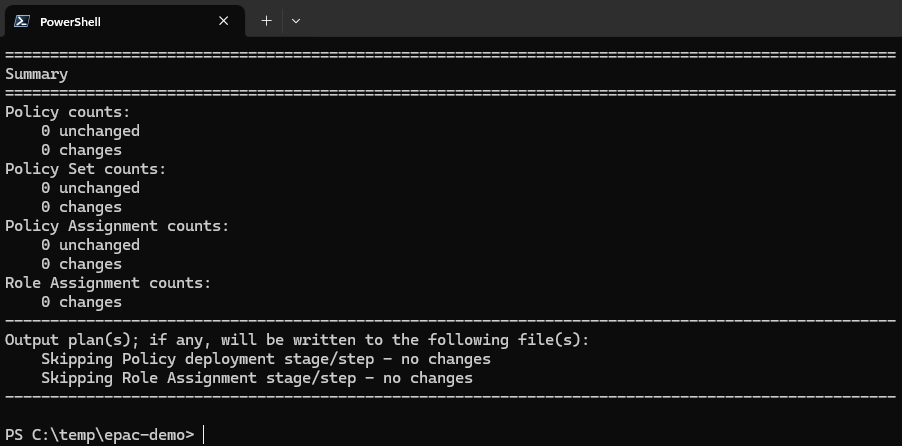
Explore desiredState strategy
To simulate an existing environment I deployed some policy resource, where is these? For EPAC to manage these resources desiredState.strategy in the global-settings file will have to be changed to full.
Set-Content -Path ".\Definitions-demo\global-settings.jsonc" -Value (
$epacGlobalSettingsContent.
Replace("{REPLACE_STRATEGY}", "full").
Replace("{REPLACE_GUID}", $epacGuid).
Replace("{REPLACE_TENANTID}", (Get-AzContext).Tenant.Id)
)
git add '.\Definitions-demo\global-settings.jsonc'
git commit -m 'added global-settings file for epac'
Build-DeploymentPlans -DefinitionsRootFolder .\Definitions-demo -PacEnvironmentSelector epac -OutputFolder Output
Rename-Item -Path .\Output\plans-epac\policy-plan.json -NewName policy-plan-full.json
Building a deployment plan now results in the file .\Output\plans-epac\policy-plan.json beeing created and the terminal output also says it will delete 2 policy assignments. But there is no mention of the policy exemptions yet..?
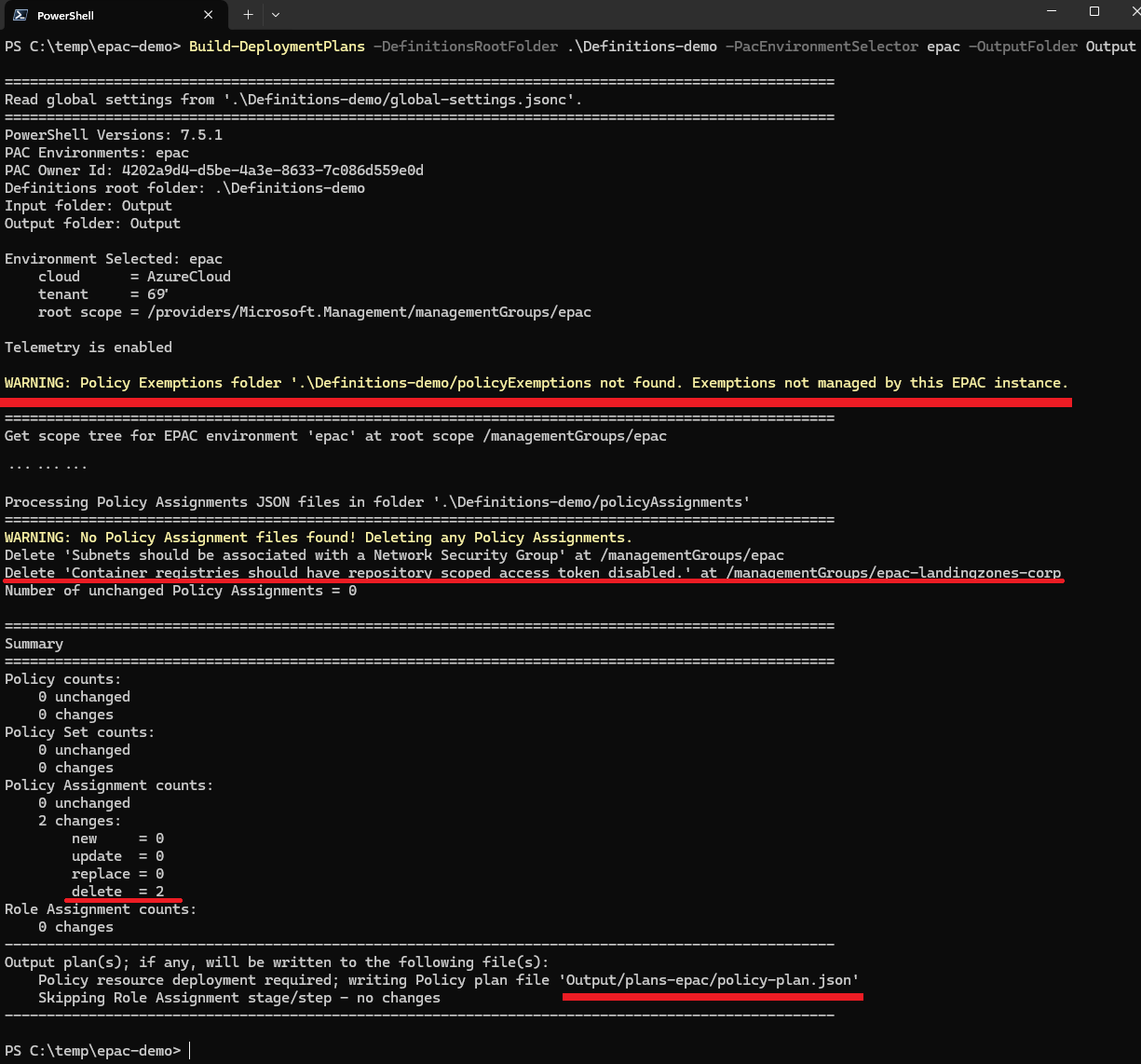
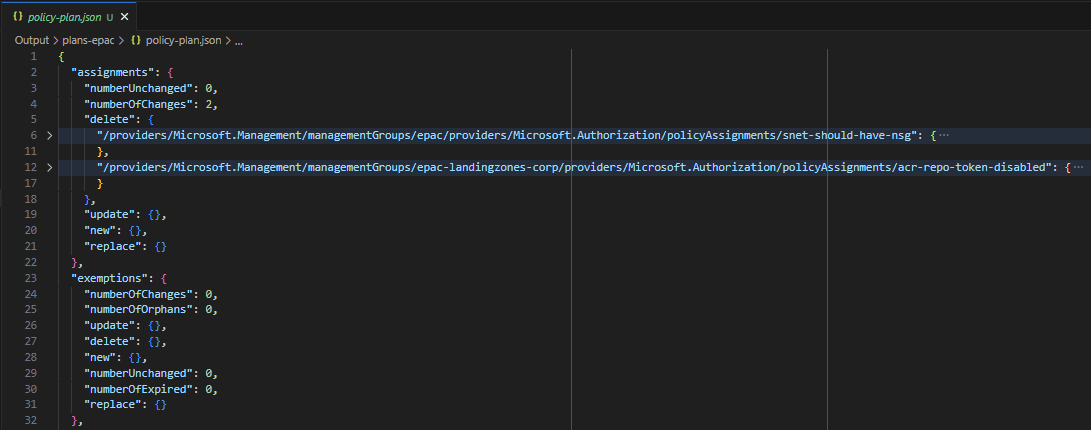
Exemptions
EPAC only manages items with a directory in the Definitions folder. This allows for different policy resources to be managed in separate repositories. The documentation offers several example use cases.
I am missing a directory for policyExemptions in my current folder structure. Since I will manage all policy resources in one centralized repo, I have to create the directory. I also create a sub-folder for each of my environments.
$splat = @{ ItemType = 'Directory' ; Force = $true }
New-Item @splat -Path .\Definitions-demo\policyExemptions\
New-Item @splat -Path .\Definitions-demo\policyExemptions\epac\
New-Item @splat -Path .\Definitions-demo\policyExemptions\epac-dev\
Doing another build deployment plan now should show deletion of both assignments and exemptions.
Build-DeploymentPlans -DefinitionsRootFolder .\Definitions-demo -PacEnvironmentSelector epac -OutputFolder Output # see expected deletions including exemptions
Rename-Item -Path .\Output\plans-epac\policy-plan.json -NewName policy-plan-full-exemptions.json

Export existing policy resources
EPAC includes support for extracting existing policy resources.
$splat = @{
DefinitionsRootFolder = '.\Definitions-demo\'
OutputFolder = '.\PolicyExport'
InputPacSelector = 'epac'
ExemptionFiles = 'json'
}
Export-AzPolicyResources @splat
The exported files should be examined and moved to their designated folder. I will create a dedicated folder for policy assignments created by my organization. This way it is possible to separate policy assignments created by us and those created by ALZ. I also create a sub-folder for each of my environments.
The policyExemptions has a metadata property, this will be removed. The metadata.deployedBy property is managed my EPAC internally.
$splat = @{ ItemType = 'Directory' ; Force = $true }
New-Item @splat -Path .\Definitions-demo\policyAssignments\CONTOSO\
New-Item @splat -Path .\Definitions-demo\policyAssignments\CONTOSO\epac\
New-Item @splat -Path .\Definitions-demo\policyAssignments\CONTOSO\epac-dev\
Move-Item -Path .\PolicyExport\export\Definitions\policyAssignments\* -Destination .\Definitions-demo\policyAssignments\CONTOSO\epac\
git add ".\Definitions-demo\policyAssignments\CONTOSO\"
git commit -m 'added existing policyAssignments'
Move-Item -Path .\PolicyExport\export\Definitions\policyExemptions\epac\* -Destination .\Definitions-demo\policyExemptions\epac\
git add ".\Definitions-demo\policyExemptions\"
# open exemptions and remove 'deployedBy' from metadata object
$jsonData = Get-Content -Path .\Definitions-demo\policyExemptions\epac\active-exemptions.jsonc | ConvertFrom-Json
$jsonData.exemptions = $jsonData.exemptions | ForEach-Object {$_.psobject.Properties.Remove('metadata') ; return $_ }
$jsonData | ConvertTo-Json -Depth 100 | Out-File '.\Definitions-demo\policyExemptions\epac\active-exemptions.jsonc'
# now compare, stage newest changes, commit
git add .\Definitions-demo\policyExemptions\epac\active-exemptions.jsonc
git commit -m 'added existing policyExemptions'
Build-DeploymentPlans -DefinitionsRootFolder .\Definitions-demo -PacEnvironmentSelector epac -OutputFolder Output
Now the build deployment plan no longer expects to delete anything! The updating of the metadata properties is EPAC taking ownership of the policy resources.

Time to deploy the policy-plan and then build a new plan to verify no more changes is expected.
$splat = @{
DefinitionsRootFolder = '.\Definitions-demo'
PacEnvironmentSelector = 'epac'
InputFolder = '.\Output'
}
Deploy-PolicyPlan @splat
Rename-Item -Path .\Output\plans-epac\policy-plan.json -NewName policy-plan-after-export.json
Build-DeploymentPlans -DefinitionsRootFolder .\Definitions-demo -PacEnvironmentSelector epac -OutputFolder Output
Integrate EPAC with ALZ policies
Assets such a policies for ALZ is stored in the GitHub repository Azure/Azure-Landing-Zones-Library. This repo has release tags for both alz and amba (Azure Monitor Baseline Alerts). EPAC has documented support for syncing policies from the ALZ-library.
The process for integrating EPAC with ALZ polices consists of generating a “policy-default-structure”-file and syncing the policies based on the information in this file. The file includes management group IDs, enforcement mode and some parameter values.
# https://github.com/Azure/Azure-Landing-Zones-Library/tree/platform/alz/2024.11.0
# https://github.com/Azure/Azure-Landing-Zones-Library/tree/platform/alz/2024.11.1
# https://github.com/Azure/Azure-Landing-Zones-Library/tree/platform/alz/2025.02.0
# Start with old ALZ-policy release
New-ALZPolicyDefaultStructure -DefinitionsRootFolder .\Definitions-demo -Type ALZ -Tag "platform/alz/2024.11.0" -PacEnvironmentSelector "epac"
# have a look at the file in the policyStructure-folder and fix it up
(Get-Content -Path 'Definitions-demo\policyStructures\alz.policy_default_structure.epac.jsonc').
Replace('/providers/Microsoft.Management/managementGroups/alzroot','/providers/Microsoft.Management/managementGroups/epac').
Replace('/providers/Microsoft.Management/managementGroups/platform','/providers/Microsoft.Management/managementGroups/epac-platform').
Replace('/providers/Microsoft.Management/managementGroups/landingzones','/providers/Microsoft.Management/managementGroups/epac-landingzones').
Replace('/providers/Microsoft.Management/managementGroups/corp','/providers/Microsoft.Management/managementGroups/epac-landingzones').
Replace('/providers/Microsoft.Management/managementGroups/online','/providers/Microsoft.Management/managementGroups/epac-landingzones').
Replace('/providers/Microsoft.Management/managementGroups/sandboxes','/providers/Microsoft.Management/managementGroups/epac-sandbox').
Replace('/providers/Microsoft.Management/managementGroups/management','/providers/Microsoft.Management/managementGroups/epac-platform-management').
Replace('/providers/Microsoft.Management/managementGroups/connectivity','/providers/Microsoft.Management/managementGroups/epac-platform-connectivity').
Replace('/providers/Microsoft.Management/managementGroups/identity','/providers/Microsoft.Management/managementGroups/epac-platform-identity').
Replace('/providers/Microsoft.Management/managementGroups/decommissioned','/providers/Microsoft.Management/managementGroups/epac-decommissioned').
Replace('"value": null','"value": "REPLACE_ME_LATER"') |
Set-Content -Path 'Definitions-demo\policyStructures\alz.policy_default_structure.epac.jsonc'
git add 'Definitions-demo\policyStructures\alz.policy_default_structure.epac.jsonc'
git commit -m 'added alz.policy_default_structure for alz-v2024.11.0'
When the file is updated with the desired values you can sync the ALZ policy resources.
Sync-ALZPolicyFromLibrary -DefinitionsRootFolder .\Definitions-demo -Type ALZ -Tag "platform/alz/2024.11.0" -PacEnvironmentSelector "epac"
# expore the filestructure and assignments
git add '.\Definitions-demo\policyDefinitions\'
git add '.\Definitions-demo\policySetDefinitions\'
git commit -m 'update policy definitions from alz-v2024.11.0'
The directory structure should now look something like this.
C:\TEMP\EPAC-DEMO
└───Definitions-demo
├───policyAssignments
│ ├───ALZ
│ │ └───epac
│ │ ├───Azure Landing Zones
│ │ ├───Connectivity
│ │ ├───Corp
│ │ ├───Decommissioned
│ │ ├───Identity
│ │ ├───Landing zones
│ │ ├───Platform
│ │ └───Sandbox
│ └───CONTOSO
│ ├───epac
│ └───epac-dev
├───policyDefinitions
│ └───ALZ
│ ├───API Management
│ ├───Security Center
│ ├─── ...
│ ├───Storage
│ └───Tags
├───policyDocumentations
├───policyExemptions
│ ├───epac
│ └───epac-dev
├───policySetDefinitions
│ └───ALZ
│ ├───API Management
│ ├───Backup
│ ├─── ...
│ ├───Compute
│ └───Trusted Launch
└───policyStructures
Change enforcementMode
To see the effect of changing a value in the policy-structure-file I will change the enforcementMode and do another sync. Inspecting the generated assignment files now will display the diff.
# stage the changes to see impact from next step
git add '.\Definitions-demo\policyAssignments\ALZ\epac\'
(Get-Content -Path 'Definitions-demo\policyStructures\alz.policy_default_structure.epac.jsonc').
Replace('"enforcementMode": "Default"', '"enforcementMode": "DoNotEnforce"') |
Set-Content -Path 'Definitions-demo\policyStructures\alz.policy_default_structure.epac.jsonc'
Sync-ALZPolicyFromLibrary -DefinitionsRootFolder .\Definitions-demo -Type ALZ -Tag "platform/alz/2024.11.0" -PacEnvironmentSelector "epac"
# see one of the changes
code '.\Definitions-demo\policyAssignments\ALZ\epac\Landing zones\Deploy-VM-Backup.jsonc'
# remove the staged files
git restore --staged '.\Definitions-demo\policyAssignments\ALZ\epac\'
git add 'Definitions-demo\policyStructures\alz.policy_default_structure.epac.jsonc'
git commit -m 'set enforcementMode to DoNotEnforce in alz.policy_default_structure'
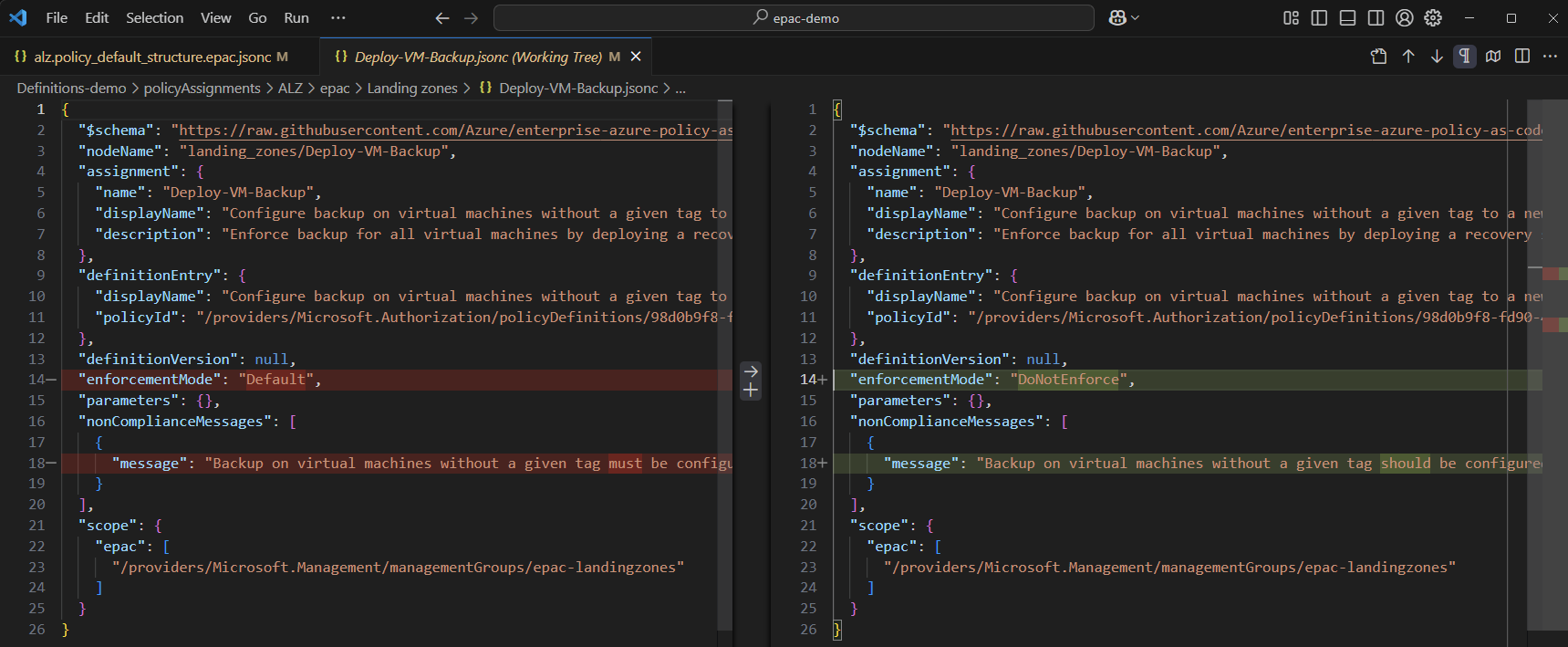
Deploy ALZ policies
All policy assignments should be examined and chosen whether to keep or not. Here I will only keep the assignments in the sandboxes and landing zones directories, the rest will not be deployed.
Now just build a deployment plan and deploy it.
Get-ChildItem -Path .\Definitions-demo\policyAssignments\ALZ\epac\ -File -Recurse |
Where-Object {$_.Directory.ToString().split('\')[-1] -notin @('sandboxes','landing zones') } |
Rename-Item -NewName { "$_.disabled" }
git add '.\Definitions-demo\policyAssignments\ALZ\epac\'
git commit -m 'update policy policyAssignments from alz-v2024.11.0'
Build-DeploymentPlans -DefinitionsRootFolder .\Definitions-demo -PacEnvironmentSelector epac -OutputFolder Output
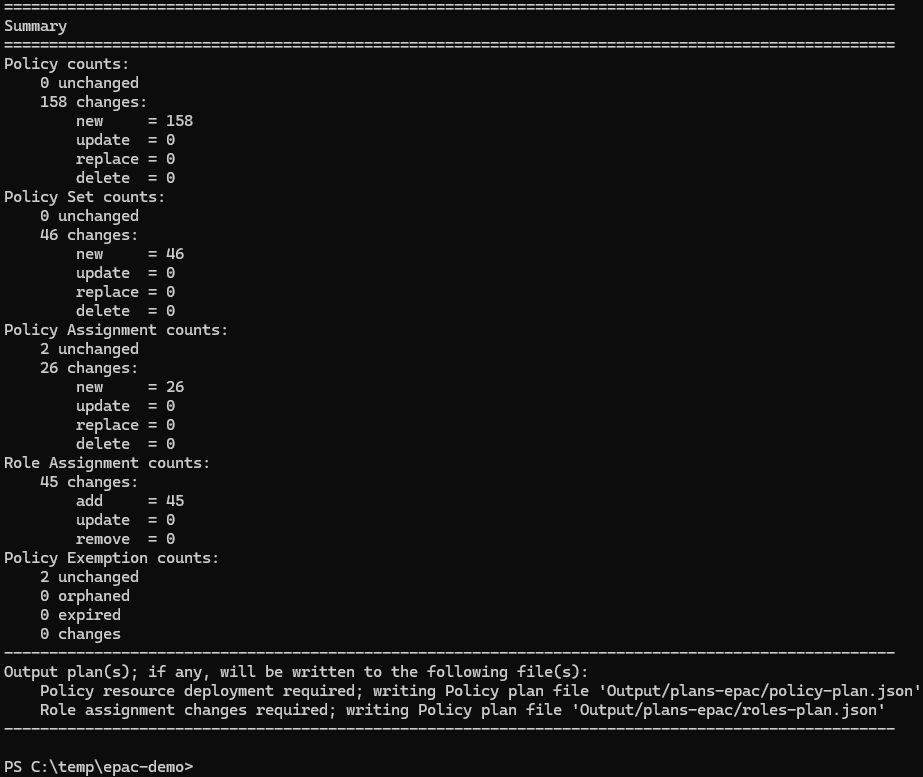
$splat = @{
DefinitionsRootFolder = '.\Definitions-demo'
PacEnvironmentSelector = 'epac'
InputFolder = '.\Output'
}
Deploy-PolicyPlan @splat
# Deploy-RolesPlan @splat # skip this for demos, required for Deploy-If-Not-Exist (DINE) assignments
The deployment will fail as this ALZ release included a faulty policy… Just remove the faulty policy and deploy again.
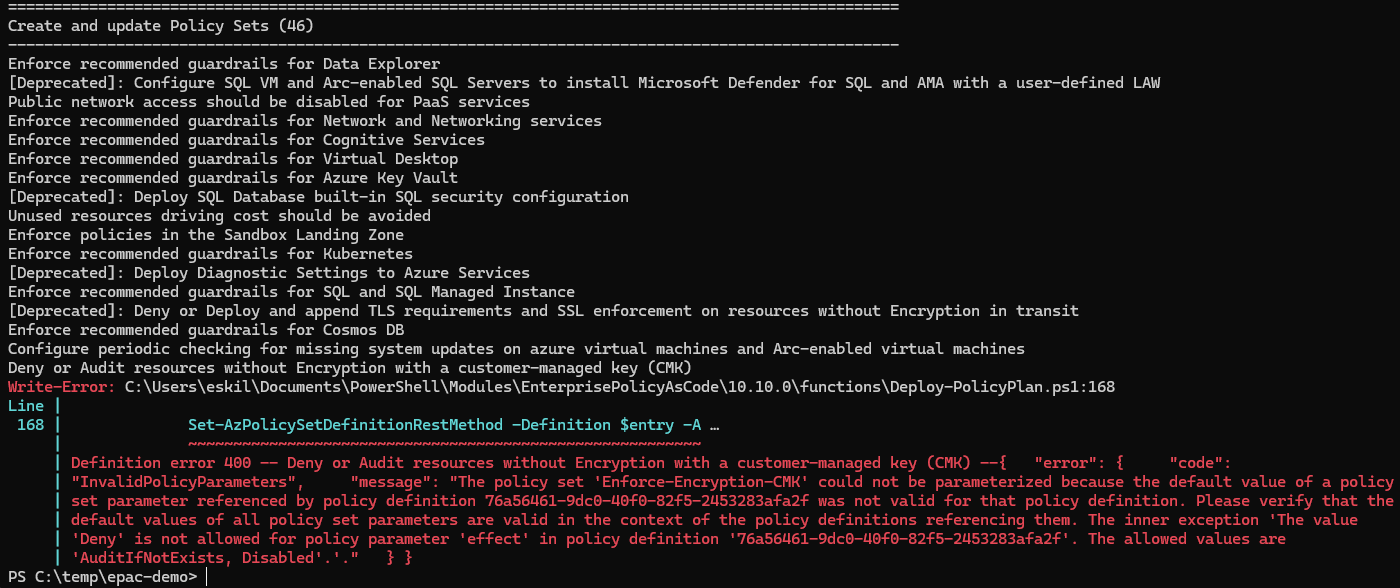
# deploy fails on first run, delte failty policy and build new plan
Remove-Item -Path .\Definitions-demo\policySetDefinitions\ALZ\Encryption\Enforce-Encryption-CMK.json
git add '.\Definitions-demo\policySetDefinitions\ALZ\Encryption\Enforce-Encryption-CMK.json'
git commit -m 'removed fault policySet'
Build-DeploymentPlans -DefinitionsRootFolder .\Definitions-demo -PacEnvironmentSelector epac -OutputFolder Output
Deploy-PolicyPlan @splat
Rename-Item -Path .\Output\plans-epac\policy-plan.json -NewName policy-plan-alz.v2024.11.0.json
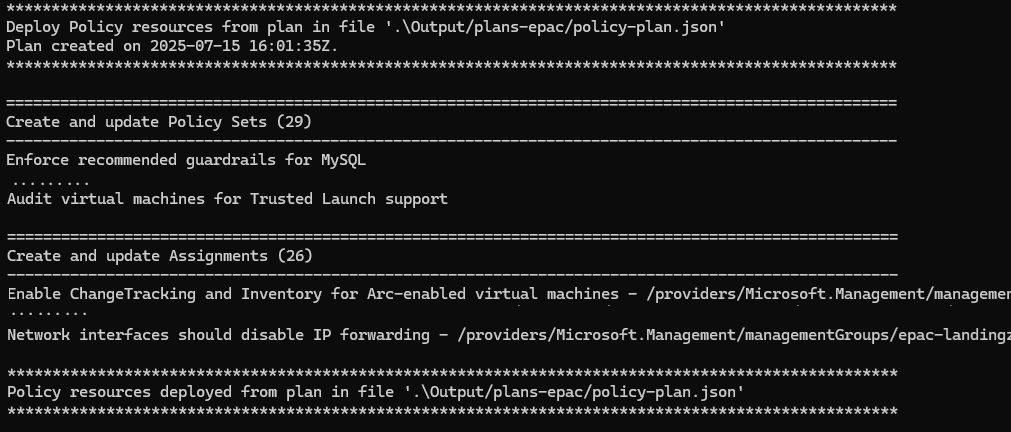
The deployment will output each deployed resource. The above deployment created 29 policySets and 26 policyAssignments.
Building another deployment plan at this point will show no changes to the environment.
Build-DeploymentPlans -DefinitionsRootFolder .\Definitions-demo -PacEnvironmentSelector epac -OutputFolder Output
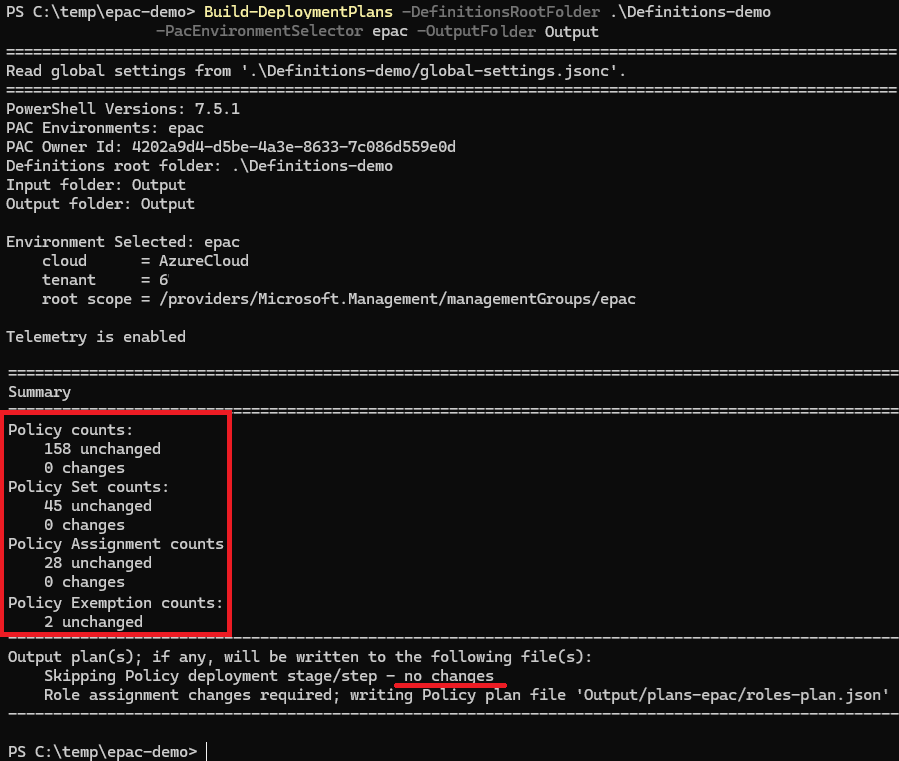
Upgrade ALZ policies
The ALZ team regularly updates the ALZ policy definitions and assignments, not on a quarterly basis. To get a grasp of what’s changed have a look at their Whats new page. And to assist in making sure you have the latest policy assignments, check out AzGovViz and it’s ALZ Policy assignments checker.
During the upgrade we have to fetch the latest policy-default-structure file and do a new sync from the ALZ-library.
Rename-Item -Path ".\Definitions-demo\policyStructures\alz.policy_default_structure.epac.jsonc" -NewName alz.policy_default_structure.epac.v2024.11.0.jsonc
New-ALZPolicyDefaultStructure -DefinitionsRootFolder .\Definitions-demo -Type ALZ -Tag "platform/alz/2025.02.0" -PacEnvironmentSelector "epac"
# have a look at the file in the policyStructure-folder and update it with correct values
(Get-Content -Path 'Definitions-demo\policyStructures\alz.policy_default_structure.epac.jsonc').
Replace('/providers/Microsoft.Management/managementGroups/alz','/providers/Microsoft.Management/managementGroups/epac').
Replace('/providers/Microsoft.Management/managementGroups/platform','/providers/Microsoft.Management/managementGroups/epac-platform').
Replace('/providers/Microsoft.Management/managementGroups/landingzones','/providers/Microsoft.Management/managementGroups/epac-landingzones').
Replace('/providers/Microsoft.Management/managementGroups/corp','/providers/Microsoft.Management/managementGroups/epac-landingzones').
Replace('/providers/Microsoft.Management/managementGroups/online','/providers/Microsoft.Management/managementGroups/epac-landingzones').
Replace('/providers/Microsoft.Management/managementGroups/sandbox','/providers/Microsoft.Management/managementGroups/epac-sandbox').
Replace('/providers/Microsoft.Management/managementGroups/management','/providers/Microsoft.Management/managementGroups/epac-platform-management').
Replace('/providers/Microsoft.Management/managementGroups/connectivity','/providers/Microsoft.Management/managementGroups/epac-platform-connectivity').
Replace('/providers/Microsoft.Management/managementGroups/identity','/providers/Microsoft.Management/managementGroups/epac-platform-identity').
Replace('/providers/Microsoft.Management/managementGroups/decommissioned','/providers/Microsoft.Management/managementGroups/epac-decommissioned').
Replace('"value": null','"value": "REPLACE_ME"').
Replace('"enforcementMode": "Default"', '"enforcementMode": "DoNotEnforce"') |
Set-Content -Path 'Definitions-demo\policyStructures\alz.policy_default_structure.epac.jsonc'
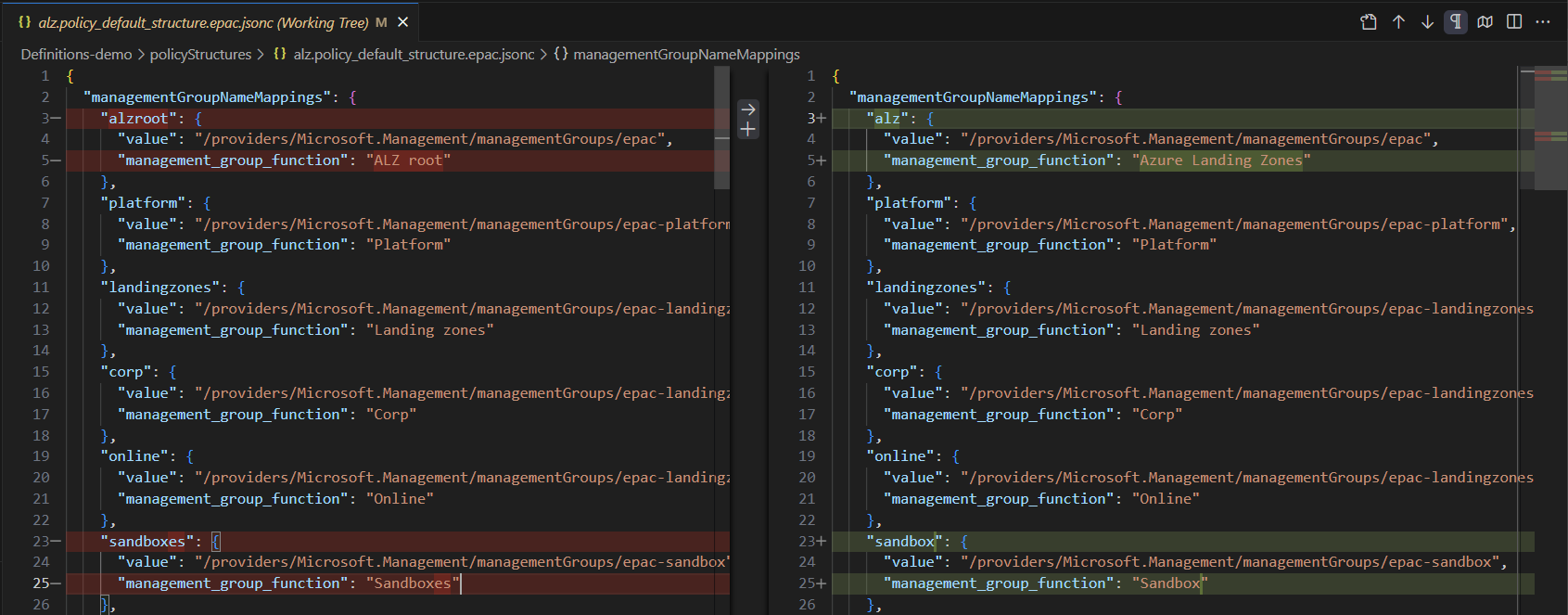
From the diff above you can see an example of whats changed in the newer release.
Before I sync the latest ALZ policies I remove the existing onces. This way I can see from the git diff what assignments are changed and what has been removed. This review process should be done manually to see I the ALZ policies is in line with your specs or not. Sometimes you might already have a customer specific policyAssignment doing the same as a new ALZ policy, keep your policy repo tidy!
For this release:
- the policyAssignments scoped to the intermediate root management group, is place in a dedicated folder
- the directory
Sandboxesis renamed toSandbox Enforce-TLS-SSL-H224is replaced byEnforce-TLS-SSL-Q225
I only keep the assignments located in the sandbox and landing zones directories.
git add 'Definitions-demo\policyStructures\alz.policy_default_structure.epac.jsonc'
git commit -m 'added alz.policy_default_structure for alz-v2025.02.0'
# remove existing policyAssignments, see git diff after sync
Remove-Item -Path .\Definitions-demo\policyAssignments\ALZ\epac\ -Recurse
Sync-ALZPolicyFromLibrary -DefinitionsRootFolder .\Definitions-demo -Type ALZ -Tag "platform/alz/2025.02.0" -PacEnvironmentSelector "epac"
git add '.\Definitions-demo\policyDefinitions\'
git add '.\Definitions-demo\policySetDefinitions\'
git commit -m 'update policy definitions from v2025.02.0'
# policy assignments scoped to intRoot is moved to a dedicated folder in the newer release
Get-ChildItem -Path '.\Definitions-demo\policyAssignments\ALZ\epac\Azure Landing Zones\' |
Rename-Item -NewName { "$_.disabled" }
# stage new (intRoot)
git add '.\Definitions-demo\policyAssignments\ALZ\epac\Azure Landing Zones\'
# stage old (intRoot)
Get-ChildItem -Path '.\Definitions-demo\policyAssignments\ALZ\epac\Azure Landing Zones\' |
ForEach-Object { git add ".\Definitions-demo\policyAssignments\ALZ\epac\$($_.Name)" }
git commit -m 'added latest policy assignments for intRoot scope'
# only keep some of the assignments
Get-ChildItem -Path '.\Definitions-demo\policyAssignments\ALZ\epac\*.jsonc' -File -Recurse |
Where-Object {$_.Directory.ToString().split('\')[-1] -notin @('sandbox','sandboxes','landing zones','azure landing zones') } |
Move-Item -Destination { "$($_.FullName).disabled" } -Force
code .
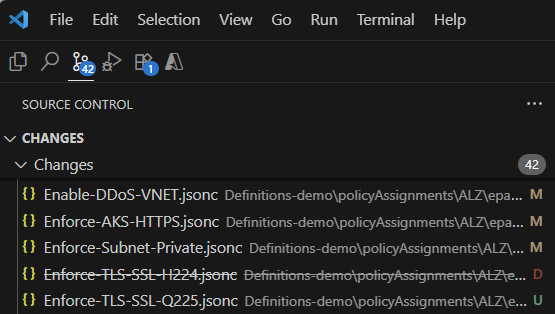
git add .\Definitions-demo\policyAssignments\ALZ\epac\Connectivity
git commit -m 'added latest policy assignments for connectivity scope'
git add .\Definitions-demo\policyAssignments\ALZ\epac\Corp
git commit -m 'added latest policy assignments for corp scope'
git add .\Definitions-demo\policyAssignments\ALZ\epac\Identity
git commit -m 'added latest policy assignments for identity scope'
git add '.\Definitions-demo\policyAssignments\ALZ\epac\Landing zones'
git commit -m 'added latest policy assignments for landing zones scope'
git add .\Definitions-demo\policyAssignments\ALZ\epac\Platform
git commit -m 'added latest policy assignments for platform scope'
git add .\Definitions-demo\policyAssignments\ALZ\epac\Sandboxes
git add .\Definitions-demo\policyAssignments\ALZ\epac\Sandbox
git commit -m 'added latest policy assignments for sandbox scope'
Now with everything reviewed and committed, build a deployment plan and deploy it.
Build-DeploymentPlans -DefinitionsRootFolder .\Definitions-demo -PacEnvironmentSelector epac -OutputFolder Output
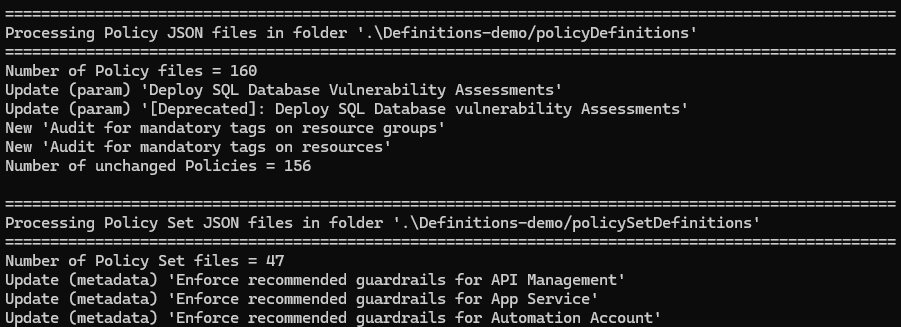
$splat = @{
DefinitionsRootFolder = '.\Definitions-demo'
PacEnvironmentSelector = 'epac'
InputFolder = '.\Output'
}
Deploy-PolicyPlan @splat
# Deploy-RolesPlan @splat # skip this for demos, required for Deploy-If-Not-Exist (DINE) assignments
Even the faulty policySet Enforce-Encryption-CMK has returned, this time without errors.

Gotchas
Tag parameter always latest
Doing the “upgrade” demo I discovered both New-ALZPolicyDefaultStructure & Sync-ALZPolicyFromLibrary did not properly handle the tag parameter, this bug should be fixed by pull request Azure/enterprise-azure-policy-as-code#996.
Closing words
This was meant as a getting started post for EPAC, there is plenty more to explore such as policy documentations, syncing AMBA policies and deploying everything from a CI/CD pipeline to both prod and the canary environments.